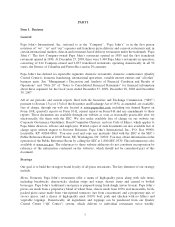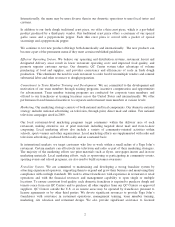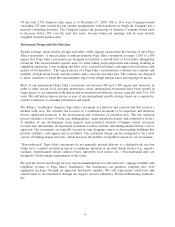Papa Johns 2009 Annual Report Download - page 18
Download and view the complete annual report
Please find page 18 of the 2009 Papa Johns annual report below. You can navigate through the pages in the report by either clicking on the pages listed below, or by using the keyword search tool below to find specific information within the annual report.11
Franchise Advisory Council. We have a Franchise Advisory Council that consists of Company and
franchisee representatives of domestic restaurants. The Franchise Advisory Council and subcommittees
hold regular meetings to discuss new product and marketing ideas, operations, growth and other relevant
issues. Certain franchisees have formed an operators’ exchange group for the purpose of communicating
and addressing issues, needs and opportunities among its members and the Company.
We currently communicate with, and receive input from, our franchisees in several forms, including
through the Company’s Franchise Advisory Council, annual operations conferences, newsletters, national
conference calls and various regional meetings conducted with franchisees throughout the year. Monthly
webcasts are also conducted by the Company to discuss current operational, marketing or other issues
affecting the franchisees’ business. We are committed to communicating with our franchisees and
receiving input from them.
Reporting and Business Processes. We collect sales and other operating information from domestic Papa
John’s franchisees daily. We have agreements with substantially all Papa John’s domestic franchisees
permitting us to debit electronically the franchisees’ bank accounts for substantially all required
payments, including the payment of royalties, Marketing Fund contributions, risk management services,
online ordering fees and purchases from our print and promotions operations and QC Centers. This
system significantly reduces the resources needed to process receivables, improves cash flow and
mitigates the amount of past-due accounts related to these items. Domestic franchisees are required to
purchase and install the Papa John’s PROFIT System in their traditional restaurants (see “Company
Operations – Point of Sale Technology”).
Comprehensive Restaurant Measurement Program. As part of our effort to deliver on our brand promise
of “Better Ingredients. Better Pizza.”, we have implemented a comprehensive measurement program for
all domestic and international restaurants. The measurement program focuses on the quality of the pizza
and the customer service experience.
Industry and Competition
The United States Quick Service Restaurant pizza industry (“QSR Pizza”) is mature and highly
competitive with respect to price, service, location, food quality and variety. There are well-established
competitors with substantially greater financial and other resources than Papa John’s. Competitors
include international, national and regional chains, as well as a large number of local independent pizza
operators. Some of our competitors have been in existence for substantially longer periods than Papa
John’s and can have higher levels of restaurant penetration and a stronger, more developed brand
awareness in markets where we have restaurants. Based on independent third-party information, the QSR
Pizza category, which includes dine-in, carry-out and delivery, had sales of approximately $33.4 billion
in 2009, of which Papa John’s share was reported at 6.0%, an increase from 5.9% reported for 2008.
Within the QSR Pizza category, we believe our primary competitors are the national pizza chains,
including Pizza Hut, Domino’s and Little Caesars, as well as several regional chains and “take and bake”
concepts. A change in pricing or other marketing strategies of one or more of our competitors could have
an adverse impact on our sales and earnings. The U.S. QSR Pizza category was negatively impacted in
2009 from the difficult economic environment. Consumers reduced discretionary spending during 2009
in response to increased unemployment and other factors. The QSR Pizza category sales were
approximately 1.0% lower in 2009 as compared to 2008. In addition, other factors have contributed to the
growth stagnation for the QSR Pizza category during the last few years, including a trend in consumers
shifting dine-out occasions toward breakfast and lunch and away from dinner. Many non-pizza restaurant
chains, including chains focusing on fresh sandwiches, have begun to emphasize dinner meals. In
























